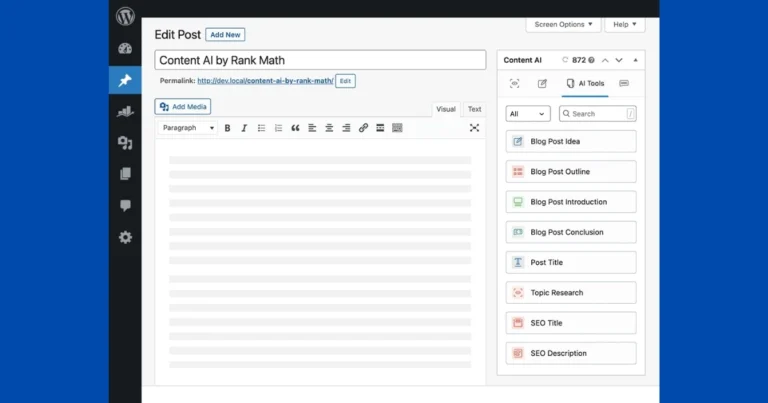In the current data-centric business world, artificial intelligence (AI) is transforming operations. It allows firms to discover new insights and make smarter choices. Sessions starting from machine learning to deep learning have changed data analytics. They now allow companies to spot unseen trends, forecast the future, and obtain an edge. So, the real query is: Are you truly utilizing AI data analysis to its full potential, to make your business soar?
We will delve into five effective methods to use AI for data scrutiny. This will redefine how your firm makes decisions. You’ll learn how to apply machine learning and predictive models. We will also cover the use of natural language processing and deep learning. These all pave the way for using AI-based data analysis to lead in your sector.
Table of Contents
Key Takeaways
- Discover the transformative power of AI in data analysis and decision-making.
- Explore five proven strategies to harness the power of AI for data analysis.
- Learn how to leverage machine learning, predictive modeling, natural language processing, and deep learning for data-driven insights.
- Uncover the benefits of adopting AI-powered data analysis, including improved accuracy, efficiency, and scalability.
- Gain a competitive edge by unlocking the full potential of AI-powered data analysis.
Introduction to AI for Data Analysis
Within today’s data-centric business models, artificial intelligence (AI) stands as a key tool. It helps organizations fully realize their data’s potential. The increasing need for data-driven decision-making highlights AI’s vital role in bettering data analysis.
The Significance of Data-Driven Decision-Making
Firms that adopt data-driven decision-making gain a significant edge. They can make informed decisions that propel their ventures. Utilizing data insights allows them to spot trends, foresee market changes, and meet customer demands promptly and accurately.
The Role of AI in Enhancing Data Analysis
Technologies like machine learning, natural language processing, and deep learning are changing how we analyze data. These tools can sift through vast amounts of information, both structured and unstructured. They uncover patterns and insights, often invisible to human eyes.
Key Benefits of Adopting AI for Data Analysis
Utilizing AI for data analysis brings numerous advantages to the table:
- Improved accuracy in data-driven insights and decision-making
- Enhanced efficiency in data management and analysis
- Increased scalability for handling big, complex datasets
- Quicker time-to-insight for faster business intelligence
Through AI’s application, organizations can elevate their data analysis efforts. This leads to smarter, data-informed decision-making. It helps in securing success in the long run.
Strategy 1: Leverage Machine Learning Algorithms
Using machine learning algorithms marks a significant stride in applying AI for data analysis. This method, integrating both supervised learning and unsupervised learning, reveals hidden patterns and offers accurate foresights. It brings valuable insight from intricate data sets.
Understanding Supervised and Unsupervised Learning
Supervised learning algorithms work with labeled data. This allows them to understand the connection between inputs and a target output. It’s ideal for modeling the prediction of upcoming trends or behaviors from past data.
Unsupervised algorithms, however, find patterns in unlabeled data. They excel at segmentation, anomaly detection, and analysis without fixed targets.
Applications of Machine Learning in Data Analysis
Machine learning algorithms find wide applications in data analysis. They change the data strategy of businesses, driving them towards insights for better decisions. They predict sales, estimate risks, and refine operations, using both supervised and unsupervised methods.
| Machine Learning Algorithms | Applications in Data Analysis |
|---|---|
| Supervised Learning | Predictive ModelingCustomer Churn PredictionFraud DetectionRecommendation Systems |
| Unsupervised Learning | Customer SegmentationAnomaly DetectionMarket Basket AnalysisDimensionality Reduction |
Grasping machine learning algorithms heralds a fresh phase in data-driven insights. It equips organizations for more informed choices and higher market competitiveness.
Strategy 2: Embrace Predictive Modeling
Organizations are constantly seeking ways to maintain their lead. The embrace of predictive modeling stands out as a vital approach in data analysis. Powered by sophisticated AI, predictive analytics allows for forecasting future trends, spotting risks, and thus making wise decisions. In doing so, businesses can secure a critical edge in the agile market of today.
Predictive modeling dives into the wealth of historical data using advanced machine learning. It predicts future outcomes and trends, allowing businesses to act ahead of time. This capability assists in handling hurdles, taking advantage of new openings, and improving overall operations. The breadth of its applications, from projecting consumer behavior to fighting fraud, is both wide and influential.
Adopting predictive modeling boosts organizational decision-making, aiding in steering through unknown territories with more vigor. The knowledge unearthed from predictive analytics aids in refining strategic plans, improving risk control, and targeting interventions more effectively. All these steps converge towards better business performance and a sounder competitive stance.
Strategy 3: Harness Natural Language Processing
Organizations are eager to tap into their data’s full potential. Natural language processing (NLP) stands out as a key tool in this quest. It enables the extraction of crucial insights from scattered sources. This strategy explores the game-changing role of NLP in analyzing data. It allows companies to uncover engaging stories from customer feedback, social discussions, and service interactions.
Text Mining and Sentiment Analysis
This strategy focuses on integrating NLP methods like text mining and sentiment analysis. Using sophisticated algorithms and machine learning, firms can sift through mountains of text. They can spot essential themes, emotions, and opinions from clients and stakeholders. Such use of NLP in text analysis deepens companies’ grasp of customer needs. It helps in making smarter, more audience-focused decisions.
Applications of NLP in Data Analysis
The use cases of NLP in data scrutiny are vast, touching many sectors. For example, in understanding customer behavior, NLP aids in tracking and analyzing sentiments. It spots trends and uncovers hidden insights. These insights, in turn, foster customer loyalty and satisfaction. In market exploration, NLP-driven text mining reveals insightful details about markets and competitors. This intelligence supports sharper strategic moves.
Besides serving customers, NLP shines in endeavors like fraud detection and compliance. It sifts through complex data from legal and financial documents. This action can catch compliance gaps early. It ensures companies follow the rules, reducing risks.
The continuously improving NLP field offers unlimited potential in data analytics. With NLP’s help, organizations can turn overlooked data into powerful insights. These insights pave the way for more educated, data-guided choices. Such decisions move their business towards success.
AI for Data Analysis
The field of data analysis is undergoing rapid change, with artificial intelligence (AI) leading the way. As organizations explore new frontiers in data-driven choices, AI serves as a catalyst. It transforms how we handle data. This discussion will focus on the significant impact of AI in analyzing and using data, notably in data visualization and advanced data mining methods powered by AI.
The Power of AI in Data Visualization
AI-driven data visualization tools mark a key breakthrough in the data analysis arena. These cutting-edge tools blend machine learning with natural language processing. They transform intricate data into clear, engaging visuals. This approach allows organizations to uncover deeper insights from their data. Consequently, they can make smart, strategic moves that foster business development.
AI-Driven Data Mining Techniques
AI’s role in data mining is also rapidly expanding, enhancing how we discover insights and patterns. Technologies like unsupervised learning and deep learning excel at revealing hidden connections within vast data pools. By deploying these methods, businesses can spot hidden opportunities and emerging trends. This insight advantage can keep them competitive in their markets.
AI’s influence stretches far beyond data visualization and mining. It powers applications like predictive modeling and sentiment analysis. Through AI, businesses can extract unparalleled insights from their data. This synergistic relationship between AI and data is reshaping decision-making, fueling sustainable growth in a data-centric world.
Strategy 4: Implement Deep Learning Techniques
Organizations aiming to extract deep insights from data now turn to deep learning techniques. A key part of data analysis, deep learning, under machine learning, transforms how businesses perceive pattern recognition, predictive modeling, and visual data processing.
Neural Networks for Pattern Recognition
In the core of deep learning are artificial neural networks, inspired by the human brain. They excel at identifying intricate patterns and relationships in massive datasets. This talent is crucial for various data analysis uses. By training these networks with abundant data, organizations enhance their pattern recognition skills. This allows them to reveal obscure insights and spot unnoticed anomalies.
Deep Learning for Predictive Modeling
Deep learning models also shine in predictive modeling. Complex neural networks enable the creation of accurate models. These models forecast trends, pinpoint risks, and guide strategic choices. The impact of deep learning on predictive modeling is transforming how data drives decisions.
Computer Vision for Image Analysis
Deep learning’s strength extends to computer vision and image analysis. It allows for automatic processing of visual data like images and videos. This is useful in quality control, anomaly spotting, data mining, and predictive maintenance. By merging deep learning with computer vision, new heights in data-centric insights and decision-making are reached.
Strategy 5: Automate Data Preprocessing
In our world today, driven by data, the quality of the data that runs your automated data preprocessing and analytics efforts is key. The fifth strategy in our series highlights the use of AI to automate data cleaning and transformation. This focus aims to make these vital tasks more efficient and precise.
The Importance of Data Quality
High-quality data forms the base of any successful AI or data analysis endeavor. Data that is poorly structured, missing, or inconsistent can harm the credibility of your findings. This damage can lead to misinformed choices and less-than-optimal results. Through automated data preprocessing and a focus on quality, companies ensure their data empowers their AI and analytical efforts. This enhancement maximizes their effectiveness and results.
Automated Data Cleansing and Transformation
AI-powered automated data cleansing and transformation techniques offer a game-changing approach to data preparation. These methods help address issues like missing data, outliers, and format discrepancies. Using these tools, organizations can overcome such challenges easily. For example, anomaly detection can pinpoint and resolve data inconsistencies. Meanwhile, feature engineering pulls valuable insights from the data. This automation makes data ready for deep analysis and decision-making.
| AI-Powered Data Preprocessing Techniques | Benefits |
|---|---|
| Anomaly Detection | Identifies and addresses outliers and irregularities in the data, ensuring data integrity and reliability. |
| Missing Data Imputation | Leverages machine learning algorithms to accurately estimate and fill in missing data points, reducing bias and improving dataset completeness. |
| Feature Engineering | Extracts and transforms relevant features from raw data, enabling more accurate and insightful data analysis and modeling. |
Adopting automated data preprocessing methods unlocks a wealth of potential for data. This approach helps companies excel in their AI-driven analytics ventures. It leads to better decision-making, heightened efficiency, and a stronger market position over time.
Overcoming Challenges in AI Adoption
Organizations face numerous hurdles in adopting AI for data analysis. They must tackle challenges such as data quality and availability issues, ethical considerations, and the requirement for a skilled workforce and comprehensive training.
Data Quality and Availability Issues
The quality and availability of data pose significant challenges in AI adoption. Inaccurate or biased data can result in misleading insights and poor decision-making. To tackle this, robust data governance strategies are essential for meeting the high standards needed for AI analysis.
Ethical Considerations in AI Implementation
Deploying AI also triggers vital ethical considerations, including worries about bias, transparency, and privacy. It’s critical that AI systems are developed with fairness, accountability, and explainability in mind. This approach helps reduce the chance of harmful outcomes and fosters trust with stakeholders.
Skilled Workforce and Training Requirements
Integrating AI effectively requires a workforce well-versed in AI systems. Constructing a team enriched with knowledge of machine learning, data science, and AI ethics is indispensable. This well-prepared workforce ensures that the organization can effectively leverage AI for data analysis.
Measuring the Success of AI-Powered Data Analysis
Organizations are now more open to using artificial intelligence (AI) for data analysis. It’s vital to gauge the success and influence of these AI efforts. To do this, setting clear key performance indicators (KPIs) is key. With these KPIs, businesses can monitor the benefits of their AI-driven data analysis.
Key Performance Indicators (KPIs)
In measuring AI’s success in data analysis, it’s important to choose KPIs that merge with strategic goals. Key KPIs cover better decision-making, enhanced efficiency, happier customers, and the ROI from AI usage. By tracking these, companies can understand AI’s real influence. This knowledge helps them decide better on future AI investments.
Continuous Monitoring and Improvement
Getting results from AI-driven data analysis is an ongoing effort. It demands steady monitoring and betterment. Setting up a solid feedback loop is important. This loop checks how AI models perform, spots areas for betterment, and applies necessary changes for continued success.
This strategy also lets businesses keep up with market shifts. They can add new data sources and upgrade their AI plans. Over time, they refine their data-driven decision-making process, securing a lead in their markets.
Regularly assessing the impact of AI data analysis and fostering a culture of steady betterment allows companies to fully leverage AI’s capabilities.
FAQ
What is the significance of data-driven decision-making in today’s business landscape?
Data-driven decision-making is pivotal in modern business. Organizations use it to make informed choices. Technology allows us to unearth insights, predict trends, and enhance our processes. As a result, companies gain an advantage in their fields.
How can AI enhance data analysis capabilities?
AI, through machine learning and deep learning, has transformed data analysis. It offers automated data preparation, uncovers patterns in vast data sets, and provides predictive intelligence. This revolution supports more insightful decision-making processes.
What are the key benefits of adopting AI for data analysis?
Applying AI in data analysis yields several advantages. It boosts the accuracy and efficiency of insights, scales to handle complex data easily, and reveals patterns critical for decision-making. These benefits are instrumental for strategic planning.
How can machine learning algorithms be applied in data analysis?
Machine learning is used in diverse analyses, from predictive models to anomaly detection. It encompasses supervised and unsupervised approaches, each with unique use cases. This versatility makes it pivotal in understanding complex data.
Why is predictive analytics important in data-driven decision-making?
Predictive analytics, powered by AI, is key for making forward-looking decisions. It forecasts trends, mitigates risks, and refines strategies. By utilizing these predictive insights, companies can improve their planning and gain a competitive advantage.
How can natural language processing (NLP) be used in data analysis?
NLP is vital for extracting insights from textual and sentiment data, like reviews and social media. It informs customer behavior and market analysis. Therefore, it’s invaluable for understanding and responding to consumer sentiments.
What is the role of AI in data visualization and data mining techniques?
AI is crucial in enhancing data visualization accuracy and complexity. It aids in understanding and conveying intricate data. Moreover, in data mining, AI uncovers complex relationships in vast data, furthering decision-making insights.
How can deep learning techniques be applied in data analysis?
Deep learning, through neural networks and computer vision, boosts pattern recognition and image analysis. In data analysis, it improves anomaly detection, quality control, and data mining processes. This leads to more refined and deep insights from data.
Why is automated data preprocessing crucial for effective data analysis?
Automated preprocessing is key to high-quality, reliable data. It ensures that data is accurate and ready for analysis. By automating these tasks, businesses can use their data more effectively, leading to better analytics outcomes.
What are some of the challenges in adopting AI for data analysis?
The hurdles in AI adoption include data quality, ethical AI use, and the skills needed for its application. Overcoming these requires addressing data issues, ethical AI deployment, and investing in a knowledgeable workforce. These challenges are essential to tackle for successful AI integration.
How can organizations measure the success of their AI-powered data analysis initiatives?
Organizations can gauge their AI analytics’ success by defining KPIs for decision-making, efficiency, and customer satisfaction. It’s imperative to continuously assess and refine these metrics to maintain the initiative’s success. This iterative approach is vital for ongoing advancement with AI.








